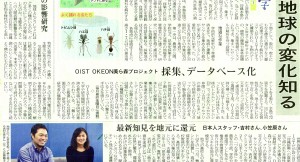
The OKEON project continues to progress and gain momentum, with the completion of site setup (72 traps on 24 sites) and being featured by various media outlets. On April 11, the Okinawa Times introduced the OKEON project as an environment monitoring network with an emphasis on insect collecting, and quoted Dr.Masashi Yoshimura, the staff scientist at Arilab and the coordinator of the OKEON project, who said that the project may collect up to six million individual specimens a year. It also promoted the importance of environmental education. The original article can be found here
Tag: OKEON
OKEON project set up all 24 sites!

On March 31, 2016, the OKEON team set up the final site for insect collection in Higashi Village, located on the northeastern part of Okinawa. There are now 24 sites with a total of 72 traps (3 traps per site) across Okinawa.
Dr. Masashi Yoshimura, a staff scientist at our lab and the coordinator of the OKEON project, was interviewed by NHK to document the completion of site setup.
OKEON project featured in Ryukyu Shinpo

Ryukyu Shinpo, an Okinawan local newspaper, reported on the OKEON project in its education section on January 29th. The article describes the project in depth, from the importance of biodiversity with an emphasis on insects and the project’s role in furthering our knowledge, to the technological aspects of the project including the use of databases and weather stations, to the process of setting up the network including communicating with collaborators, planning the sites and setting up traps.
OKEON project not only serves as a monitoring network of the terrestrial ecosystem in Okinawa, it also exemplifies one of OIST’s goals of “Contributing to the promotion Okinawa (沖縄振興への貢献)” as the project provides local knowledge back to the local people. In particular, the article emphasized the role of Masashi Yoshimura and Masako Osagawara, a staff scientist and a technician of the Economo lab, as they served as links between the project and the local people. For example, they have involved local high school students in the project and taught them about insect biodiversity and collecting methods.
Full article can be accessed here
